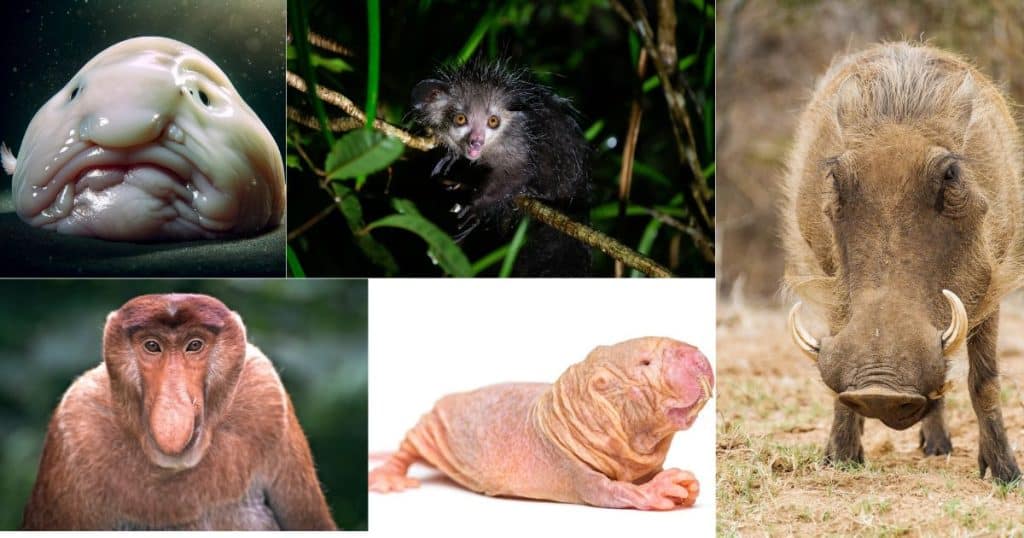The animal kingdom is brimming with diverse beauty and, intriguingly, some creatures that are compelling in their lack of conventional attractiveness. Here’s a list of animals often considered the “ugliest” in the world, each with its own unique charm that defies the typical standards of beauty.
Blobfish: A Gelatinous Wonder
Imagine a fish that looks like a grumpy, gelatinous blob – that’s the Blobfish. Native to deep waters off the coasts of Australia and Tasmania, this creature’s unusual appearance is due to its lack of bones and muscles. It’s a fascinating example of how nature prioritizes function over form.

Despite its comically gloomy expression, the blobfish is a marvel of adaptation. It’s not built for beauty contests — its body composition is designed to withstand the intense pressure of the deep ocean. Its gelatinous body is less dense than water, allowing it to effortlessly float above the sea floor to ambush prey. It consumes edible matter that floats into its path, conserving energy in its harsh environment where food is scarce.
The blobfish’s unusual appearance has made it somewhat of an internet sensation, becoming the mascot for the Ugly Animal Preservation Society. However, being ugly doesn’t mean it’s safe from danger. The blobfish, though not officially classified as an endangered species, faces significant threats. Deep-sea trawling for crustaceans, a process that involves dragging a net along the sea floor, destroys the blobfish’s habitat and often results in the unintended capture of these gelatinous creatures. As a result, their population is likely to be experiencing decline, reminding us that all creatures, regardless of their aesthetic appeal, deserve our respect and protection.
Naked Mole Rat: A Subterranean Oddity
Naked Mole Rats, with their wrinkled pink skin and large, protruding teeth, are a sight to behold. These rodents are not just about their looks; they have an incredible resistance to cancer and pain, making them a subject of intense scientific study.
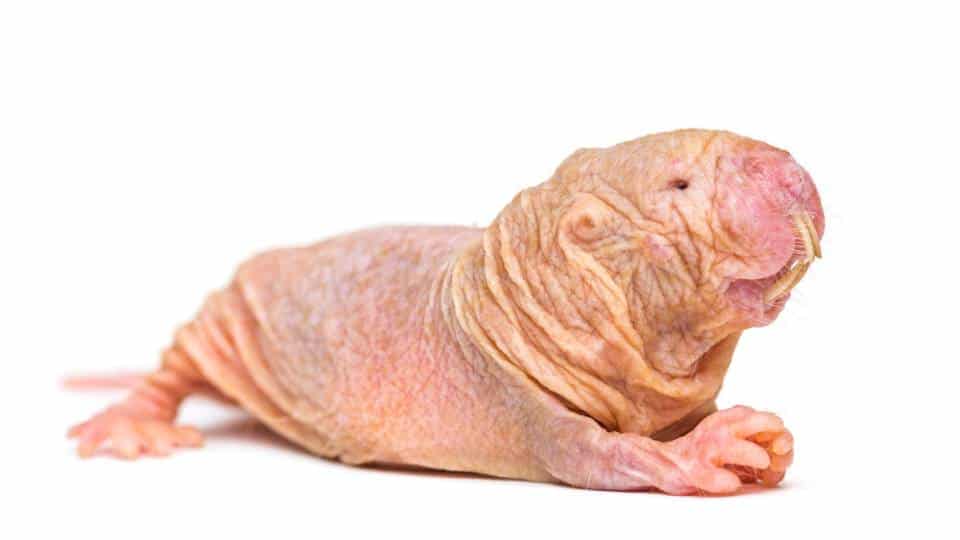
These intriguing creatures live in the subterranean realms of East Africa, with a lifespan of up to 30 years, which is exceptionally long for a rodent. Their highly social behavior is similar to that of ants or bees, living in complex, hierarchical colonies with a single breeding queen and worker rats that manage various tasks. This “eusocial” system is unique among mammals, further adding to the Naked Mole Rat’s intrigue.
Naked Mole Rats are not currently endangered. They are widespread and plentiful in the regions they inhabit, largely due to their effective subterranean lifestyle. Living underground protects them from many predators and environmental threats, resulting in stable population numbers.
However, their natural habitat could be impacted by human activity, such as agriculture and urban development, which often leads to habitat destruction. Therefore, while not currently at risk, it is crucial to monitor their populations and habitats to ensure their continued survival, underscoring the importance of conservation efforts for all species, regardless of their aesthetic appeal.
Aye-Aye: Madagascar’s Nocturnal Enigma
When it comest to the ugliest animal competition, this one must be up there. With its large, eerie eyes, long bony fingers, and scruffy fur, the Aye-Aye from Madagascar often garners a reputation for being less than appealing. However, its unique features are adaptations for nocturnal life, making it a fascinating creature of the night.

The Aye-Aye’s bony middle finger is particularly noteworthy, as it is longer and thinner than the others. This adaptation allows it to tap on tree bark to locate grubs and insects underneath, a behavior known as percussive foraging. Once it finds its prey, the Aye-Aye uses the same finger to hook the food out, exemplifying nature’s ingenuity in adaptation.
In spite of their odd charm, Aye-Ayes are unfortunately considered endangered. Deforestation and habitat loss as a result of agricultural practices and urban development pose serious threats to their survival. Additionally, they are often killed on sight due to local superstitions. Efforts are being taken by various conservation groups to preserve these unique nocturnal creatures, reminding us once again that all species, regardless of their aesthetic, are intricate parts of the vast biodiversity of our planet and deserve protection.
Proboscis Monkey: Nature’s Unusual Primate
The Proboscis Monkey, found in Borneo, is famous for its large, bulbous nose. This distinctive feature, especially prominent in males, is a remarkable example of how certain traits evolve to become symbols of attractiveness within a species.

Beyond its notable nose, the Proboscis Monkey possesses a potbelly, another unusual feature that contributes to its distinctive appearance. The belly is a byproduct of its unique digestive system, specifically adapted to break down the leaves it consumes, which forms a large part of its diet. Furthermore, their loud honking sounds, which are amplified by their large noses, serve as an effective communication tool, particularly during mating season.
Despite their odd charm, Proboscis Monkeys are unfortunately listed as an endangered species. They face significant threats from habitat loss due to deforestation and illegal hunting. As they are highly dependent on mangroves and riverine forests, the conversion of these areas into palm oil plantations has particularly affected their populations. In response to these threats, conservation efforts, including habitat protection and population monitoring, are being implemented to protect this unusual primate. This reiterates the need to appreciate and conserve all creatures, regardless of their physical appeal, as they all play crucial roles in maintaining the balance of our planet’s ecosystems.
Warthog: A Rugged Beauty
Warthogs might not win any beauty contests with their prominent tusks and bristly hair. Yet, these creatures are incredibly adaptable and resilient, thriving in a variety of habitats across Africa.
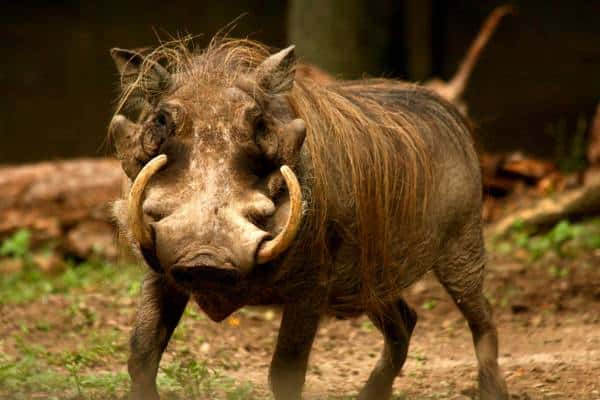
Primarily found in the grasslands, savannas, and woodland regions, warthogs are aptly named for the ‘warts’ or protective pads that protrude from their faces. These robust animals have a distinctive mane that runs down their spines to the middle of their backs, ending with a tuft on the tail, which stands erect when they run, possibly to signal alarm to others. Warthogs are herbivores, feeding mainly on grass, roots, bulbs, and berries. Their long tusks, which are actually elongated canine teeth, are used for digging food, fighting with rivals, and defending against predators. The larger upper tusks are formidable weapons, while the lower ones, though smaller, are razor-sharp and can inflict serious wounds.
Warthogs are not currently classified as endangered. They are quite widespread across Sub-Saharan Africa, and their population numbers are healthy in protected areas. However, outside these areas, they are vulnerable to hunting and habitat loss. As adaptable as they are, their survival is still reliant on the availability of suitable habitats and the tolerance of local communities. This underscores the importance of maintaining natural habitats and implementing sustainable land use practices to ensure the survival of these unique, often overlooked creatures.
Monkfish: An Aquatic Oddball
The Monkfish, with its gaping mouth and jagged teeth, could easily star in a horror movie about a deep sea creature. It’s a master of camouflage and an adept predator, proving that beauty truly is skin deep.
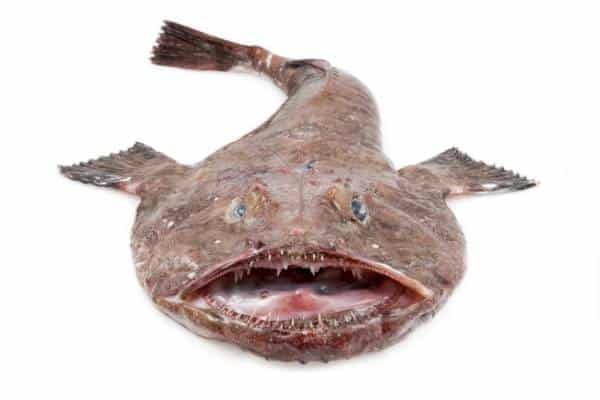
The Monkfish, sometimes referred to as the “sea devil,” is an intriguing creature of the deep sea. Its body is mostly head, adorned with a monstrous-looking mouth filled with razor-sharp teeth. Its skin, a mottled brown, allows it to blend perfectly with the sandy ocean floor, making it a formidable ambush predator. The Monkfish has a unique method to attract prey – it uses a modified spine that acts like a fishing rod with a fleshy, luminous bait at the end. When unsuspecting fish approach the lure, the Monkfish quickly snaps them up. Its expansive mouth and extendable stomach enable it to consume prey up to twice its own size.
Monkfish are not currently classified as endangered. They are widely distributed across the North Atlantic, from the coast of North Carolina in the United States, up to the Arctic Circle, and as far south as the Mediterranean and Black Seas. The primary threat to Monkfish is commercial fishing, where they are caught for their tails and livers, considered delicacies in many cuisines. However, their population is deemed to be stable due to management measures that limit the number and size of fish that can be caught. The story of the Monkfish is a testament to the fact that even the most unusual and ‘ugly’ creatures play a significant role in our ecosystem and deserve our recognition and conservation efforts.
California Condor: Majestic in Flight
While the California Condor might not be conventionally attractive with its bald head and massive wingspan, it’s a symbol of successful conservation efforts. Once near extinction, these birds are a testament to nature’s resilience.

The California Condor, the largest North American land bird, boasts a striking appearance that some might find off-putting. With a bald head, akin to a vulture’s, it might fall short of our traditional standards of beauty and is certainly an unusual looking bird. However, its sheer size — with a wingspan of up to 9.5 feet — brings a certain majesty, especially when in flight. Their bald heads, devoid of feathers, actually serve a critical function, helping them stay clean and prevent infection as they feed on carrion. Their glossy black feathers contrast sharply with the bright orange or pink of their bare heads and necks, providing them with a unique, if unconventional, charm.
Sadly, the California Condor is a critically endangered species. Its population was decimated by lead poisoning, habitat destruction, and poaching, reaching a low of just 27 individuals in the 1980s. However, thanks to the rigorous efforts of conservation organizations, including captive breeding and reintroduction programs, the population has slowly started to increase. As of 2020, there were more than 400 California Condors living in the wild and in captivity. Despite these increases, the species still faces significant challenges, including ongoing lead exposure from ingested ammunition, underscoring the vital importance of continued conservation and recovery efforts.
Star-Nosed Mole: A Sensory Powerhouse
Imagine a mole with a star-shaped set of tentacles on its nose! The Star-Nosed Mole, found in North America, uses this unique feature for sensory perception, making it one of the most extraordinary creatures in the animal world.
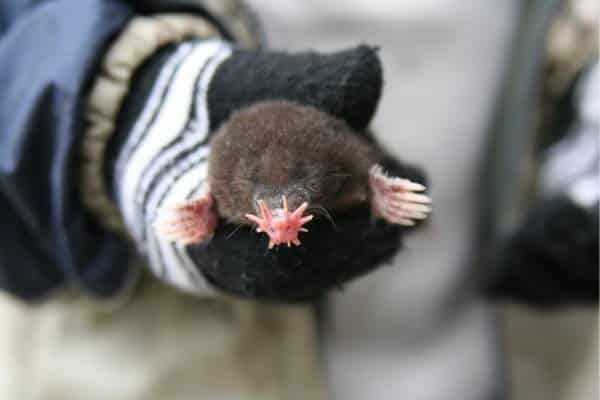
The Star-Nosed Mole is a truly unique creature, one that challenges our conventional notions of beauty. Native to the low wetlands of Eastern Canada and the North-Eastern United States, this mole is easily identified by its most distinctive feature – a pink, star-shaped nose comprising 22 fleshy tentacles. This ‘nose’ or ‘star,’ amazingly, is a sensory powerhouse containing more than 25,000 minute sensory receptors, known as Eimer’s organs. This makes the Star-Nosed Mole one of the most sensitive creatures on the planet. It uses this exceptional organ to identify food with amazing rapidity – it can decide whether or not to eat an item in just 8 milliseconds! This mole is also an accomplished swimmer and digger, using large, paddle-like front paws to navigate the saturated soils in which it lives.
The Star-Nosed Mole is not currently classified as endangered. Its population appears to be stable over its wide range, and it does not have any major threats. Although it inhabits wetlands, an ecosystem often under pressure from human activities, its ability to also live in a variety of other habitats, including forests and fields, provides some level of protection. Nonetheless, like all wild species, the Star-Nosed Mole’s continued survival will be predicated on our ability to conserve natural habitats and limit unnecessary disruptions to the ecosystem.
Horseshoe Bat: A Distinctive Mammal
Horseshoe Bats have complex, leaf-like structures on their noses, giving them a peculiar look. These structures aid in their echolocation abilities, proving that sometimes functionality takes precedence over aesthetics.
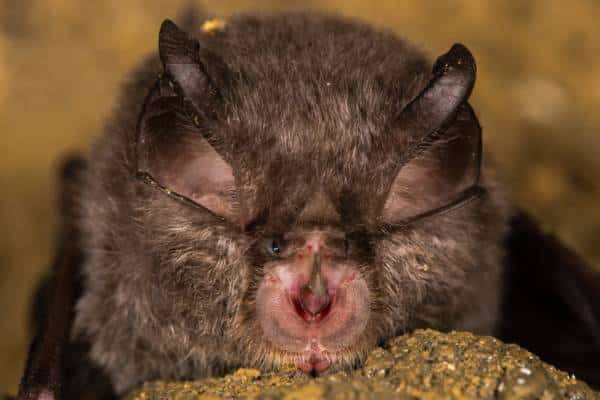
Horseshoe Bats, named after the distinctive, horseshoe-shaped, fleshy structure on their noses, are a fascinating group of bats. These bats are found widely across tropical and temperate regions of Eurasia, Africa, and the Indian subcontinent. Despite their somewhat peculiar appearance, with complex, leaf-like nasal structures, these physical attributes serve an important function. These structures, known as nose-leafs, play a critical role in the bat’s echolocation process. The nasal emissions of the sonar-like signals used for echolocation and the shaping of the sound waves for precise navigation and hunting are facilitated by these nose-leafs. Horseshoe Bats can thus navigate adeptly even in total darkness, and accurately locate and capture tiny insects mid-flight.
Horseshoe Bats are not universally endangered, but their conservation status varies by specific species. Out of approximately 100 species of Horseshoe Bats, a handful are considered critically endangered or endangered, mostly due to habitat loss and degradation. Other species are classified as vulnerable or near threatened, while many remain unclassified due to lack of sufficient data. Therefore, it’s crucial to increase research and conservation efforts to protect these distinctive mammals, ensuring that their echolocation calls continue to resonate in the night sky.
Tarsier: An Eye-Popping Primate
Tarsiers, from Southeast Asia, have enormous eyes in relation to their body size. These nocturnal primates might look bizarre, but their large eyes are crucial for their survival in the dark.
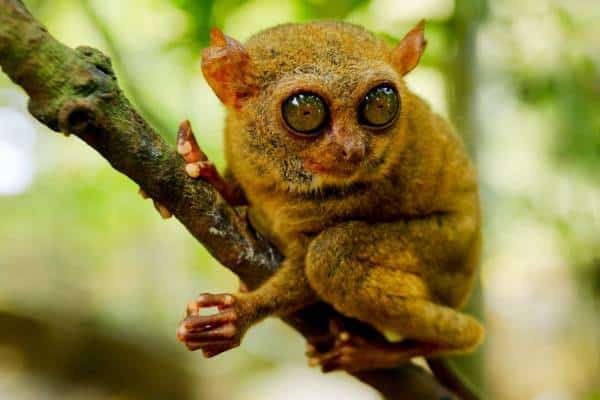
Found primarily in the Southeast Asia islands, Tarsiers are a group of small primates known for their disproportionately huge eyes. In fact, their eyes are so large in relation to their body size that each eye is heavier than their brain! These nocturnal creatures use their large, orb-like eyes to enhance their vision in the dark, as they hunt for insects and small animals. Tarsiers also possess exceptionally long fingers and toes, topped with rounded, adhesive pads that assist them in grip and mobility. Their powerful hind limbs enable them to leap distances up to 40 times their own body length.
Tarsiers, with their strange appearance, are certainly unique, yet they are an essential part of the ecosystems they inhabit. Most Tarsier species are currently listed as threatened or endangered, largely due to habitat destruction and fragmentation, hunting, and the illegal pet trade. Many species have small population sizes and live in rapidly shrinking habitats, making them particularly vulnerable to extinction. These increasingly rare animals, with their alien-like features and spectacular leaping abilities, underscore the rich diversity of life on our planet and the importance of conservation efforts to preserve such uniqueness.
Axolotl: An Endearing Amphibian
Axolotls, with their wide mouths and external gill stalks, have a unique, almost alien appearance. These fascinating amphibians are capable of regenerating lost limbs, showcasing nature’s incredible adaptability.

The Axolotl, often referred to as the ‘Mexican walking fish,’ is a type of salamander that truly stands out due to its unusual features. It possesses fringed, external gill stalks and a wide, endearing smile that lend it an almost alien appearance. However, it’s the axolotl’s regenerative capabilities that truly set it apart in the animal kingdom. This fascinating amphibian has the ability to regenerate not only lost limbs but also heart tissue, spinal cord, and parts of its brain and eyes. This extraordinary ability has piqued the interest of scientists, who hope that studying axolotls could contribute to advancements in human medicine.
However, the axolotl is currently listed as critically endangered by the International Union for Conservation of Nature (IUCN). Its natural freshwater habitat in Xochimilco, a system of lakes and canals near Mexico City, is under severe threat from pollution and urbanization. Moreover, invasive species, such as carp and tilapia, pose significant challenges to the axolotl by consuming its food sources and offspring. Urgent conservation efforts are necessary to protect this remarkable creature and its unique biological abilities. Conservation strategies include improving water quality, regulating invasive species, and preserving the axolotl’s natural habitats. Despite their seemingly odd appearance, axolotls play a significant role in our understanding of regenerative biology and the health of freshwater habitats.
Lamprey: A Jawless Wonder
Lampreys are jawless fish with a toothed, funnel-like sucking mouth. While their appearance can be unsettling, lampreys are a vital part of aquatic ecosystems and have existed for millions of years.
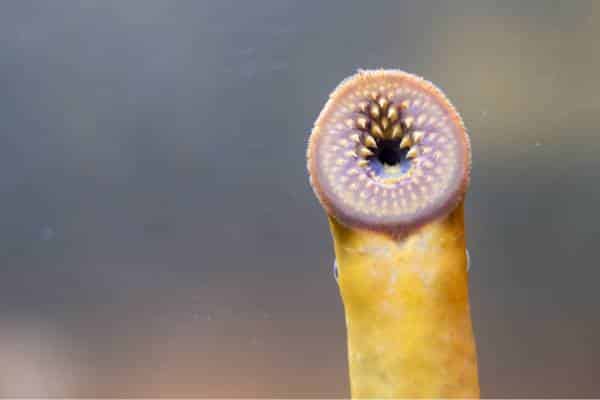
Lampreys, often referred to as “living fossils,” are a fascinating group of jawless fish that have remained largely unchanged for hundreds of millions of years. Their peculiar, somewhat disconcerting appearance is characterized by a toothed, funnel-like sucking mouth, which they use to attach themselves to the skin of other fish for feeding. Despite being boneless, lampreys have a remarkably well-developed nervous system, as evidenced by their ability to navigate complex aquatic environments.
Lampreys play a critical role in maintaining the health of aquatic ecosystems. They act as a natural control mechanism for various fish species, preventing overpopulation and promoting biodiversity. Some lamprey species are also known to migrate between freshwater and saltwater environments, a behavior that can help distribute nutrients across different ecosystems.
The conservation status of lampreys varies greatly among the approximately 40 recognized species. While some species are considered least concern by the International Union for Conservation of Nature (IUCN), others are classified as vulnerable or endangered. Factors such as river pollution, the construction of dams and other man-made barriers, and climate change-induced habitat loss are the primary threats to lamprey populations. Therefore, conservation efforts are needed to protect these unique creatures, whose ecological roles and evolutionary history are as complex as their appearance.
Dugong: A Gentle Sea Cow
Dugongs, large marine mammals related to manatees, have a stout, torpedo-shaped body and a distinctive snout. Their serene and gentle nature contrasts with their somewhat cumbersome appearance.

Dugongs, fondly known as “sea cows,” are remarkable marine mammals that grace the warm coastal waters of the Indian and western Pacific Oceans. One of the distinctive features of these creatures is their stout, torpedo-shaped body, which can grow up to 3 meters in length. Their skin is thick and smooth, typically a shade of grey or brown, changing in color as they age. What truly sets them apart is their dolphin-like tail used for propulsion and their unique crescent-shaped snout designed for efficient foraging of sea grasses, their primary food source. Dugongs are peaceful, slow-moving creatures that often spend a significant portion of their day grazing on the ocean floor. Despite their somewhat bulky appearance, these gentle giants are surprisingly graceful swimmers.
Dugongs are, unfortunately, facing numerous threats that have led to their classification as vulnerable by the International Union for Conservation of Nature (IUCN). Their slow reproduction rate and long lifespan – they can live up to 70 years – make them particularly susceptible to threats such as hunting, habitat loss due to coastal development, pollution, and accidental entanglement in fishing nets. Conservation efforts are crucial to ensure the survival of this unique species. These efforts not only aim to protect the dugongs themselves but also the marine grasslands they inhabit and depend on for sustenance. Indeed, the plight of the dugongs is indicative of the broader challenges facing marine ecosystems worldwide.
Sloth: Slow and Steady
Sloths, known for their slow movements and permanent “smile,” might not be conventionally cute. However, their slow lifestyle is a remarkable adaptation to their environment, conserving energy efficiently.

Sloths are intriguing creatures that have ingeniously adapted to their environment by living a slow-paced lifestyle. Distinguished by their long limbs, small ears, and short tails, sloths are most known for their permanent, endearing “smile.” Their bodies are typically 50 to 60 cm long, with a unique fur that grows in a direction opposite to that of most mammals. This growth pattern accommodates their upside-down lifestyle, allowing rainwater to drain away swiftly. Additionally, their fur provides a hospitable environment for moths, beetles, and fungi, making sloths a mobile mini-ecosystem. The slow lifestyle of the sloth is a superb adaptation strategy, helping them conserve energy efficiently, as their leaf-heavy diet does not offer much nutritional value.
Sloth populations are classified as endangered, vulnerable, or of least concern, depending on the species. For instance, the Maned Three-Toed Sloth is considered endangered due to severe habitat loss and fragmentation, whereas the Brown-Throated Three-Toed Sloth is listed as least concern due to its ability to adapt to a range of habitats. Regardless, deforestation, illegal pet trading, and hunting are persistent threats affecting all sloth species. Thus, conservation action is crucial for protecting these remarkable creatures and their unique ecological roles.
Giant Anteater: A Long-Nosed Insectivore
Giant Anteaters have a large, elongated nose and a shaggy coat of fur. These unique-looking animals use their powerful claws to dig for ants and termites, showcasing nature’s endless inventiveness.
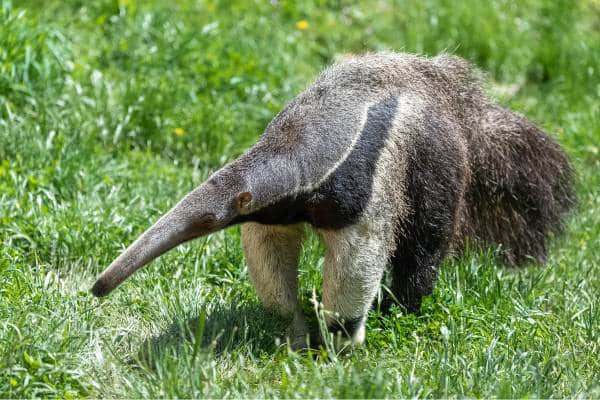
Giant Anteaters, or Myrmecophaga tridactyla, are among nature’s most uniquely designed creatures, with their large, elongated snout and shaggy, coarse fur. They can grow up to 7 feet long, and their bushy tail often accounts for more than half of that length. Their long nose isn’t just for show – it houses a sticky, two-foot-long tongue which they use to consume their primary diet of ants and termites. A single giant anteater can consume up to 30,000 insects in a day! Their powerful, curved claws are not only formidable weapons against predators like jaguars and pumas but are also perfect for digging into ant hills.
These solitary mammals are primarily found in Central and South America. Their preference for grasslands, deciduous forests, and rainforests has unfortunately put them in direct conflict with human activities such as agriculture and urban development. The International Union for Conservation of Nature (IUCN) currently lists the Giant Anteater as “Vulnerable.” Habitat loss, road kills, and hunting for their fur and meat are the primary threats to their survival. Continued conservation efforts are therefore essential to ensure the preservation of these distinctive creatures and the ecosystems they inhabit.
Goblin Shark: A Deep-Sea Mystery
Goblin Sharks, with their elongated, flattened snouts and protruding jaws, are often termed “living fossils.” These rare sharks are a window into the ancient past of the oceans.
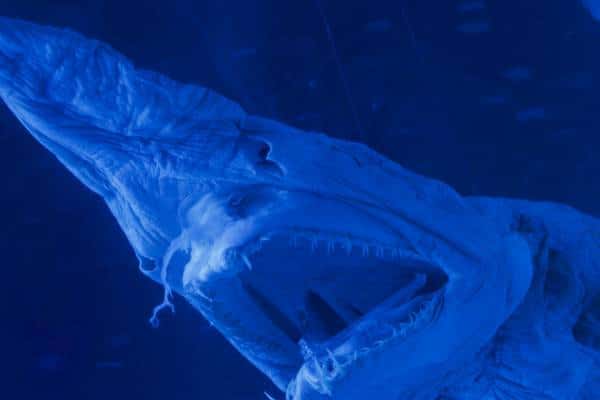
Goblin Sharks, scientifically known as Mitsukurina owstoni, are indeed a window into the marine history, often referred to as ‘living fossils’ due to their ancient lineage dating back over 125 million years. These unusual-looking creatures inhabit the deep sea, typically found at depths of 100 to 1,300 meters. They are characterized by their elongated, flattened snouts and distinctive, protruding jaws filled with long, slender teeth. Their skin, devoid of any scales, is uniquely flabby, and their color ranges from pinkish-gray to dull pink due to their blood vessels showing through their semi-transparent skin. When hunting, their jaws can shoot out to snare their prey, a feature facilitated by the specialized ligaments in their jaws. This jaw protrusion, combined with their needle-like teeth, makes them formidable hunters despite their seemingly sluggish nature.
Despite their eerie appearance, Goblin Sharks pose no significant threat to humans, primarily due to their deep-sea habitat. Regrettably, like many deep-sea creatures, not much is known about their population trends, breeding habits, or overall life cycle. According to the International Union for Conservation of Nature (IUCN), Goblin Sharks are currently listed as “Least Concern,” primarily due to their widespread distribution and presumed large population. However, they are occasionally caught as bycatch in deep-sea fishing nets, which could potentially pose a threat to their population in the future. Consequently, more research is needed to fully understand these mysterious creatures and the potential risks they face in their deep-sea homes.
Matamata Turtle: Nature’s Odd Sculpture
Native to South America, the Matamata Turtle has a rough, knobby shell and a wide, flat head with a snorkel-like nose. It looks more like a piece of bark or a leaf than a turtle, which helps it blend into its environment.
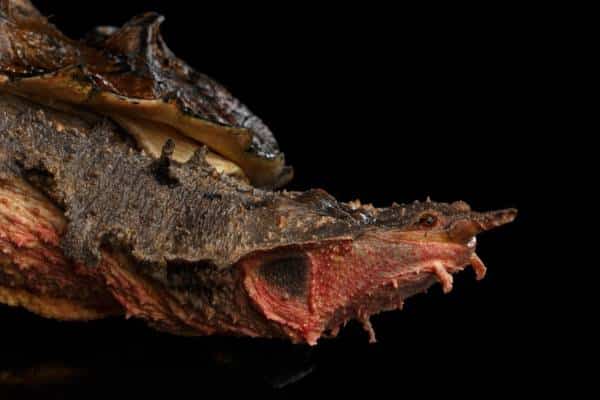
The Matamata Turtle, or Chelus fimbriatus, is an intriguing creature that piques interest with its peculiar appearance. With an unmistakable rough, wart-covered shell and a wide, flat head that resembles a chunk of bark, the Matamata is nature’s spectacularly ‘ugly’ sculpture. Its astonishingly long, tubular, snorkel-like nose serves an essential function, enabling it to breathe while largely submerged in water. Being bottom-dwellers, they prefer the still, slow-moving waters of marshes, swamps, or stagnant pools of rivers where they lie still, camouflaging effortlessly with the surrounding detritus and leaves.
The Matamata is an excellent ambush predator. Its wide mouth and large throat enable it to create a low-pressure vacuum to suck in prey, typically small fish and invertebrates. This process is so swift that it’s challenging to see with the naked eye. With such a specialized mode of feeding, the Matamata seldom leaves water, except for nesting.
Regarding conservation status, the Matamata Turtle is currently not listed as endangered. The International Union for Conservation of Nature (IUCN) has not evaluated it due to lack of sufficient data. However, like many other wildlife species, it faces potential threats from habitat loss and pet trade. Therefore, monitoring and conservation efforts are essential to ensure the survival of this uniquely grotesque yet fascinating turtle species.
Red-Lipped Batfish: Ocean’s Quirky Dweller
Found around the Galapagos Islands, the Red-Lipped Batfish is known for its bright red lips and unusual body structure, which is more suited for ‘walking’ on the ocean floor than swimming.
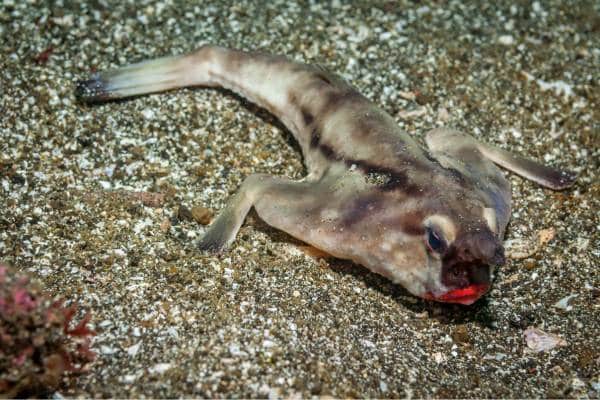
The Red-Lipped Batfish, officially known as Ogcocephalus darwini, is truly one of the ocean’s eccentric characters. Boasting a distinctly ‘made-up’ appearance with its bright red lips, it captures attention and often provokes a chuckle. However, beyond its seemingly lipstick-smudged lips, the Red-Lipped Batfish has other unique attributes. Its body structure is peculiarly adapted to ‘walking’ on the ocean floor rather than swimming. The pectoral fins have evolved to function more like legs, and a bony, flat projection on the head, a lure, is used for attracting unsuspecting prey, primarily small fish and invertebrates. This bottom-dwelling species is most commonly found around the Galapagos Islands at depths of up to 120 meters.
Despite its unusual appearance and unique adaptations, the Red-Lipped Batfish is not currently listed as an endangered species. The International Union for Conservation of Nature (IUCN) has categorized it under “Least Concern.” This classification primarily stems from the fact that its population appears stable and it faces no major known threats. However, like all marine life around the Galapagos Islands, they are inherently vulnerable to changes in the ocean environment, pollution, and potential overfishing. Therefore, continued monitoring and conservation efforts are essential to ensure the survival of this quirky sea dweller.
Sphynx Cat: A Feline Enigma
The Sphynx Cat, known for its lack of fur, has a unique appearance that sets it apart from other cat breeds. Their wrinkled skin and large ears give them a distinctive, somewhat alien look.

The Sphynx Cat, officially recognized by the International Cat Association in 1979, is truly an enigma in the world of felines. This breed’s most defining characteristic is its near-total lack of fur, making it appear naked and exposing its wrinkled skin. This nakedness gives the Sphynx an exotic, even alien-like appearance, far removed from the ‘fluffy’ image we typically associate with domestic cats. This breed’s large, lemon-shaped eyes, often a piercing blue or green, and oversized, bat-like ears add to its distinctive look.
What the Sphynx lacks in fur, it makes up for in personality. This breed is known for being friendly, playful, and excessively fond of human companionship. It is an active, intelligent cat that loves to explore its surroundings and interact with its human family. Despite their slightly ‘unconventional’ appearance, Sphynx cats have a warm, gentle demeanor that quickly endears them to their owners.
In terms of conservation status, the Sphynx is not endangered. As a breed specifically developed by humans through selective breeding, the Sphynx is well-established in the pet trade and is quite popular due to its unusual appearance and affectionate nature. However, it’s worth noting that potential Sphynx owners should thoroughly research and find reputable breeders to ensure they are supporting ethical breeding practices, as the Sphynx cats do have some health issues related to their lack of fur, such as susceptibility to sunburn and certain skin conditions.
Hyena: Striped and Spotted
Hyenas have long been associated with ugliness, but their unique striped and spotted coats are a testament to the diversity of life. These intelligent social animals play crucial roles in their ecosystems.

The Hyena, a distinctive creature often maligned in folklore and popular culture, is as fascinating as it is misunderstood. With their hunched back and irregular, ‘lop-sided’ gait, Hyenas may not conform to traditional ideas of animal beauty. However, they possess a unique charm in their distinctive striped and spotted coats. This coat variation signifies different species within the hyena family, namely the Striped Hyena (Hyaena hyaena) and the Spotted Hyena (Crocuta crocuta). Both species are highly intelligent and social animals, living in complex hierarchical groups known as clans.
Hyenas play an essential role in maintaining ecological balance. Their scavenging habits help keep their ecosystems clean by consuming the remains of dead animals. Yet, they are not merely scavengers but efficient hunters as well, capable of taking down prey many times their size. Their powerful jaws can crush bones, enabling them to extract nutrition unavailable to many other creatures.
In terms of conservation status, the Spotted Hyena is listed as ‘Least Concern’ by the IUCN, primarily due to its widespread distribution and large global population. On the other hand, the Striped Hyena, with its more limited distribution and declining population, is classified as ‘Near Threatened.’ Both species face threats from habitat loss, hunting, and poisoning, often related to human-wildlife conflict. Hence, continued conservation efforts are vital to ensure their survival and the overall health of their ecosystems.
Chinese Giant Salamander: Elusive Amphibian
The Chinese Giant Salamander is the world’s largest amphibian, with some individuals reaching lengths of up to six feet. This elusive creature spends most of its life hidden under rocks and in the water, making it challenging to study. However, its importance cannot be underestimated.
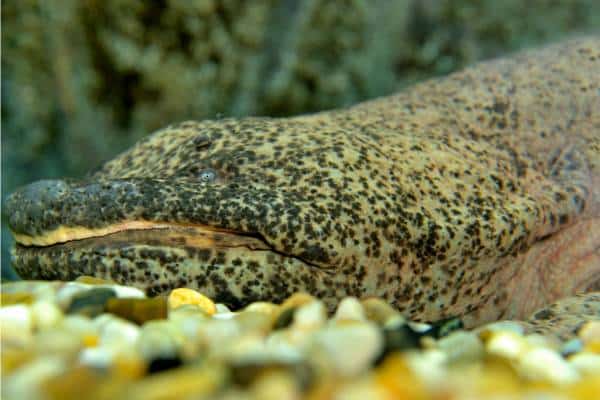
As a top predator in its ecosystem, the Chinese Giant Salamander plays a vital role in controlling populations of other species, such as fish and insects. Its unique adaptations, such as the ability to regenerate lost limbs, make it a fascinating subject for scientific research. Unfortunately, due to habitat loss and overharvesting for use in traditional Chinese medicine, this species is critically endangered.
Efforts are underway to protect the remaining population of Chinese Giant Salamanders through conservation and breeding programs. However, continued awareness and action are necessary to ensure the survival of this elusive and important amphibian species. Overall, the Chinese Giant Salamander serves as a reminder of the delicate balance of nature and the impact humans can have on even the most resilient creatures. It also highlights the need for sustainable practices in both land use and traditional medicine to protect the diversity of life on our planet. So, while these giant salamanders may be elusive, their significance in our ecosystem cannot be ignored. As we continue to learn more about this fascinating species, it is essential that we also work towards its preservation for future generations to appreciate and study.
Nature’s Diversity
Each of these animals, though not fitting the traditional mold of beauty, is an incredible testament to the diversity and adaptability of life on Earth. Their unique features often serve specific survival functions, reminding us that in nature, sometimes the most unconventional traits are the most fascinating.
Unconventional traits in animals often serve vital ecological functions that play a significant role in maintaining biodiversity and the overall health of ecosystems. For instance, the Axolotl’s ability to regenerate lost limbs aids in its survival, allowing it to thrive and contribute to the ecological balance of its habitat. Similarly, the Star-Nosed Mole’s unusual nose enhances its sensory perception, providing it an advantage in foraging and escaping predators, thereby aiding its population stability. The Monkfish’s mastery of camouflage helps maintain a predatory balance in the deep sea, ensuring a stable food web.
These attributes, however unique or peculiar they may seem, attest to nature’s ingenious solutions for survival and adaptation. Through these unconventional traits, species not only ensure their own survival but also contribute significantly to the ecological dynamics of their habitats.
Nature’s diversity is truly a wonder to behold, and these unconventional animals are just a glimpse of its infinite possibilities. So the next time you see an animal that doesn’t fit the traditional definition of beauty, remember that there is so much more to them than meets the eye. Their unique traits serve a purpose in their world and contribute to the fascinating mosaic of life on our planet.
Conclusion: The Ugliest Animal In the World?
So which of these unique but ugly animals could be said to be the ugliest? Well, ultimately the beauty of all animals in the world is in the eye of the beholder. Each species serves an essential function in their ecosystem, and it is that significance that should be appreciated rather than their outward appearance.
So instead of labeling any animal as the ugliest, let’s celebrate nature’s diverse creations and work towards preserving them for the future.

